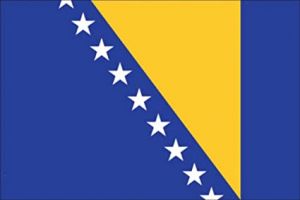Language/Bosnian/Grammar/Subject-Verb-Object
| ◀️ Special Characters and Sounds — Previous Lesson | Next Lesson — Questions and Negations ▶️ |
Welcome to the "Subject-Verb-Object" lesson of the Complete 0 to A1 Bosnian Course! In this lesson, we will explore one of the most fundamental aspects of the Bosnian language: its basic sentence structure, which follows the Subject-Verb-Object (SVO) order. Understanding this structure is essential for forming coherent sentences and communicating effectively in Bosnian.
Why is the SVO structure important, you ask? Well, just like how a recipe needs the right ingredients in the correct order to create a delicious dish, a sentence needs its components arranged properly to convey clear meaning. By mastering the SVO order, you’ll be able to express your thoughts and ideas in Bosnian with confidence.
Outline of the Lesson:
1. Understanding Subject-Verb-Object Structure
2. Detailed Examples
3. Practice Exercises
4. Conclusion
Let's dive in!
Understanding Subject-Verb-Object Structure
In Bosnian, the basic sentence structure consists of three main components:
- Subject (S): The person or thing performing the action.
- Verb (V): The action being performed.
- Object (O): The person or thing receiving the action.
This structure is quite similar to English, making it easier for English speakers to grasp. For instance, in the sentence "I eat an apple," "I" is the subject, "eat" is the verb, and "an apple" is the object.
In Bosnian, this would translate to "Ja jedem jabuku," where:
- Ja (I) is the subject
- jedem (eat) is the verb
- jabuku (an apple) is the object
Detailed Examples
To illustrate the SVO structure, let's look at some examples. We will present 20 sentences that follow the Subject-Verb-Object format.
| Bosnian | Pronunciation | English |
|---|---|---|
| Ja čitam knjigu. | Ja chee-tam k’nyi-goo. | I read a book. |
| Ti pišeš pismo. | Ti pee-sesh pees-mo. | You write a letter. |
| On gleda film. | On gled-a film. | He watches a movie. |
| Ona jede kolač. | O-na ye-de ko-lach. | She eats a cake. |
| Mi igramo fudbal. | Mi ee-gra-mo food-bal. | We play football. |
| Vi učite Bosanski. | Vi oo-che-te Bosan-ski. | You (plural) learn Bosnian. |
| Oni slušaju muziku. | O-ni sloo-sha-yu moo-zi-ku. | They listen to music. |
| Ja volim čaj. | Ja vo-leem chai. | I love tea. |
| Ti kupuješ voće. | Ti koo-poo-ye-sh vo-che. | You buy fruit. |
| On vozi auto. | On vo-zi au-to. | He drives a car. |
| Ona čisti kuću. | O-na chee-stee koo-choo. | She cleans the house. |
| Mi jedemo meso. | Mi ye-de-mo me-so. | We eat meat. |
| Vi gledate televiziju. | Vi gled-a-te te-le-vi-zi-yu. | You (plural) watch television. |
| Oni rade u vrtu. | O-ni ra-de oo vur-tu. | They work in the garden. |
| Ja pišem dnevnik. | Ja pee-shem dne-vneek. | I write a diary. |
| Ti crtaš sliku. | Ti tsar-tash slee-koo. | You draw a picture. |
| On trči maraton. | On tur-chee ma-ra-ton. | He runs a marathon. |
| Ona voli životinje. | O-na vo-lee zhee-vo-tee-nye. | She loves animals. |
| Mi putujemo u grad. | Mi poo-too-ye-mo oo grad. | We travel to the city. |
| Vi slušate radio. | Vi sloo-sha-te ra-dee-o. | You (plural) listen to the radio. |
| Oni pomažu prijateljima. | O-ni po-ma-zhu pri-ya-tel-y-ma. | They help their friends. |
Practice Exercises
Now that we have explored the SVO structure and looked at examples, let's put your knowledge to the test with some exercises!
1. Identify the Subject, Verb, and Object: Read the following sentences and identify the subject, verb, and object.
- A. Ja učim Bosanski.
- B. Oni igraju tenis.
2. Translate the Sentences: Translate the following sentences from English to Bosnian using the SVO structure.
- A. She reads a book.
- B. We watch a movie.
3. Form Your Own Sentences: Create your own sentences by using the given subjects, verbs, and objects.
- Subjects: Ja (I), Ti (You), Mi (We)
- Verbs: pišem (write), kupujem (buy), igramo (play)
- Objects: pismo (letter), voće (fruit), fudbal (football)
4. Correct the Sentences: Identify and correct the mistakes in the following sentences.
- A. Gleda on film.
- B. Kolač ona jede.
5. Fill in the Blanks: Complete the sentences with the appropriate verb.
- A. Ja _______ čaj. (make)
- B. Ti _______ voće. (eat)
6. Sentence Rearrangement: Rearrange the following words into a correct SVO sentence.
- A. jabuku / On / jede.
- B. film / Ti / gledaš.
7. Listening Exercise: Listen to a native speaker say a sentence and write down the SVO components.
8. Group Work: In pairs, ask each other questions using the SVO structure and respond using complete sentences.
9. Short Story Creation: Write a short story of 5 sentences using the SVO structure.
10. Role Play: Role-play a conversation in Bosnian using the SVO structure, focusing on a specific scenario, like ordering food or asking for directions.
Conclusion
Congratulations on reaching the end of this lesson! By now, you should have a solid understanding of the Subject-Verb-Object structure in Bosnian. Remember, practice is key to mastering any language. Use the exercises provided to reinforce your learning, and don’t hesitate to come back to this lesson whenever you need a refresher.
Keep up the great work, and see you in the next lesson where we will delve into forming questions and negations in Bosnian!
Sources
Other Lessons
- Bosnian Alphabet and Pronunciation
- Nouns
- Questions and Negations
- Gender
- Past Tense
- Verbs and Conjugation
- Plurals
- Personal Pronouns
- Comparatives and Superlatives
| ◀️ Special Characters and Sounds — Previous Lesson | Next Lesson — Questions and Negations ▶️ |

